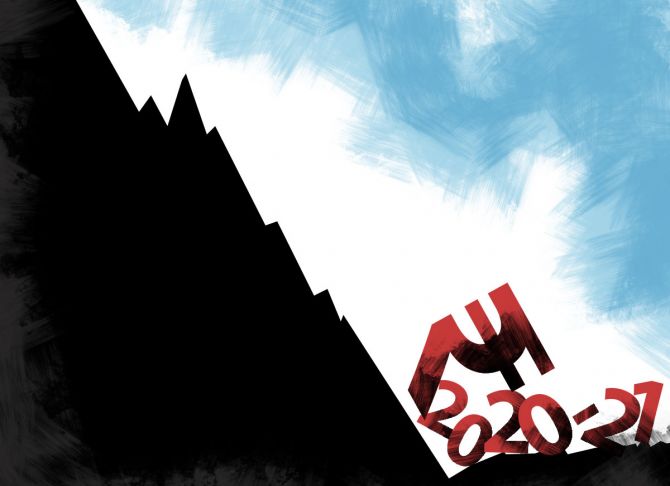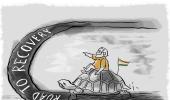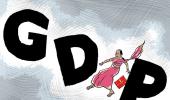Clearly, the extra borrowing of Rs 4.2 trillion the government has planned so far will not be enough to meet the shortfall in revenues which could be between Rs 8 trillion and Rs 10 trillion, points out A K Bhattacharya..

What would be the extent of deviation in the government's revenue and expenditure from what was projected in February 2020 in the Budget Estimate for the current financial year?
An answer to this question lies partially in the provisional actuals of the Union government's revenue and expenditure, already available for the first half of 2020-21.
According to these numbers, the Centre's net tax revenue collections are estimated at Rs 4.58 trillion, just about 28 per cent of the full year's target.
The performance of non-tax revenue and disinvestment receipts is worse at just about 24 per cent and 3 per cent of the annual target for 2020-2021, respectively.
The expenditure side of the government's finances, however, is quite impressive in the first half of the year, with total expenditure at Rs 14.8 trillion staying at about 49 per cent of the annual target.
To be fair, the dismal show on revenue numbers reflects the pattern of India's economic growth in the first two quarters of 2020-2021.
The National Statistical Office had estimated that the economy had contracted by about 24 per cent in the April-June period of 2020.
The Reserve Bank of India has now put out its advance assessment for growth in the July-September period of 2020.
It expects the economy to contract by 8.6 per cent.
In other words, the first half of 2020-2021 may see a contraction of a little over 16 per cent.
The big question is whether the revenue situation will get better after the latest RBI assessment of a recovery in the second half of 2020-2021.
The November bulletin of the central bank has forecast that growth could return to the Indian economy by the October-December period of 2020, a quarter ahead of the earlier estimates.
This forecast is, of course, based on the assumption of a continued upturn in economic activity.
Nevertheless, it is reasonable to assume that the economy will show growth in the second half of the current year, in contrast to a contraction in the first half.
And, therefore, revenue collections in the second half of the current year would see higher growth.
But the bigger question is: By how much more will the second half revenue grow? The trends seen in the past three years could be a pointer.
In the second half of 2019-2020, the Union government's net tax revenue collection was 23 per cent more than what it collected in the first half.
The corresponding number was 26 per cent in 2018-19 and 29 per cent in 2017-2018.
In the first three Budgets of the Modi government, the net tax revenue collected in the second half was even higher than that in the first half.
But that share stabilised at between 23 and 29 per cent in the last three years.
Equally notable is the fact that the last three years did not see a significant bump in growth in the second half of the year, compared to that in the first half.
Indeed, the second-half growth in gross domestic product was lower than that in the first half in two of the three years.
It was 3.6 per cent in the second half of 2019-2020, compared to 4.8 per cent in the first half of the same year.
Similarly, GDP in the second half of 2018-2019 grew by 5.65 per cent, compared to 6.65 per cent in the first half.
In 2017-218, the second half saw a growth rate of 7.9 per cent, compared to the first half growth rate of 6.4 per cent.
Yet, the net tax revenue for the Centre in the second half of the last three years was 23-26 per cent more than what was collected in the first half.
Given that the economy in the second half of 2020-2021 should see growth, compared to a contraction in the first half, and the second half of the year has traditionally seen a jump in tax collection, the net tax revenue in the October-March period of 2020-2021 should be much higher than that in the first half of the current year.
But there is no way the tax revenue growth will be enough to reach the Budget target of Rs 16.36 trillion.
Indeed, going by the past trend, the net tax revenue shortfall should be quite large, in the range of Rs 5.85 trillion to Rs 6.12 trillion.
If the second-half tax revenue collection ends up being 55 per cent more than that in the first half (this was achieved in 2015-2016), then the tax revenue shortfall would be lower at Rs 4.65 trillion.
The trends in divestment receipts and non-tax revenue are more worrying.
Divestment receipts usually see a big increase in the second half, but even after taking account of that, the divestment receipts this year are bound to fall short of the target of Rs 2.1 trillion.
This assumes that BPCL's stake sale will go through this year and LIC's initial public offer may be put off till next year.
Non-tax revenue in 2020-2021 is hugely dependent on telecom spectrum fees.
A little over a third of the total expected non-tax revenue of Rs 3.85 trillion is to come from telecom services, a target that now looks difficult in view of the recent court rulings.
The recent directive to State-owned companies to transfer higher dividends may provide only some comfort.
Going by past increases in second-half collections over the first-half of the year, the shortfalls in divestment and non-tax revenue could be in the range of Rs 1.5-Rs 1.8 trillion and Rs 1.6-Rs 1.8 trillion, respectively.
The government's expenditure will not be a major problem, as this has already been reined in the first half, when at Rs 14.79 trillion it is actually less than what was spent in the same period of 2019-20.
Moreover, the government has been adept at slashing expenditure in the second half of the year.
In the last three years, expenditure in the second half was 14-22 per cent less than that in the first half of the year.
In the current year, however, such savings may prove to be elusive, with the stimulus packages having already imposed a small additional fiscal cost.
Nevertheless, expenditure slippages this year would not be significant.
So, the big challenge for the government in the second half would be to shore up revenue collections.
Going by the past trend of collections in the second half of the year and by the expected recovery in economic output, the net tax revenue shortfall should be Rs 6 trillion in a worst-case scenario and Rs 4.65 trillion in the best-case scenario.
If you add the shortfall of Rs 3.1-Rs 3.6 trillion on account of disinvestment receipts and non-tax revenues, the total revenue gap could be between Rs 8 trillion and Rs 10 trillion.
Clearly, the extra borrowing of Rs 4.2 trillion the government has planned so far will not be enough to meet the shortfall.
The inevitable conclusion is that the government has to go in for some extra borrowing.
It could also go for a mix of extra borrowing and expenditure management by either deferring a part of the current year's expenditure or shifting it to the accounts of State-owned enterprises, as was done in the past two years.
Feature presentation: Aslam Hunani/Rediff.com











